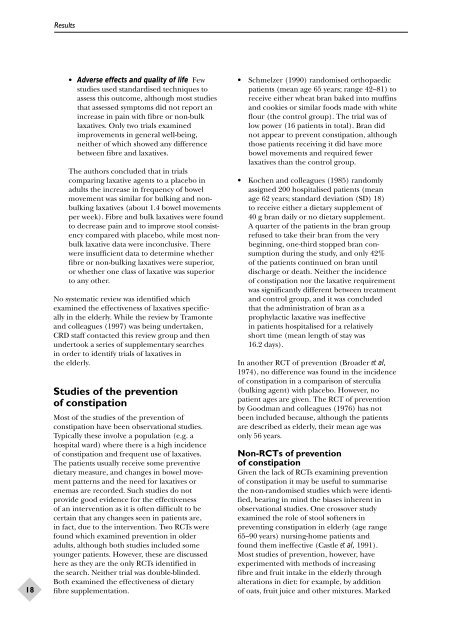Effectiveness of Laxatives in the Elderly - NIHR Health Technology ...
Effectiveness of Laxatives in the Elderly - NIHR Health Technology ...
Effectiveness of Laxatives in the Elderly - NIHR Health Technology ...
Create successful ePaper yourself
Turn your PDF publications into a flip-book with our unique Google optimized e-Paper software.
18<br />
Results<br />
• Adverse effects and quality <strong>of</strong> life Few<br />
studies used standardised techniques to<br />
assess this outcome, although most studies<br />
that assessed symptoms did not report an<br />
<strong>in</strong>crease <strong>in</strong> pa<strong>in</strong> with fibre or non-bulk<br />
laxatives. Only two trials exam<strong>in</strong>ed<br />
improvements <strong>in</strong> general well-be<strong>in</strong>g,<br />
nei<strong>the</strong>r <strong>of</strong> which showed any difference<br />
between fibre and laxatives.<br />
The authors concluded that <strong>in</strong> trials<br />
compar<strong>in</strong>g laxative agents to a placebo <strong>in</strong><br />
adults <strong>the</strong> <strong>in</strong>crease <strong>in</strong> frequency <strong>of</strong> bowel<br />
movement was similar for bulk<strong>in</strong>g and nonbulk<strong>in</strong>g<br />
laxatives (about 1.4 bowel movements<br />
per week). Fibre and bulk laxatives were found<br />
to decrease pa<strong>in</strong> and to improve stool consistency<br />
compared with placebo, while most nonbulk<br />
laxative data were <strong>in</strong>conclusive. There<br />
were <strong>in</strong>sufficient data to determ<strong>in</strong>e whe<strong>the</strong>r<br />
fibre or non-bulk<strong>in</strong>g laxatives were superior,<br />
or whe<strong>the</strong>r one class <strong>of</strong> laxative was superior<br />
to any o<strong>the</strong>r.<br />
No systematic review was identified which<br />
exam<strong>in</strong>ed <strong>the</strong> effectiveness <strong>of</strong> laxatives specifically<br />
<strong>in</strong> <strong>the</strong> elderly. While <strong>the</strong> review by Tramonte<br />
and colleagues (1997) was be<strong>in</strong>g undertaken,<br />
CRD staff contacted this review group and <strong>the</strong>n<br />
undertook a series <strong>of</strong> supplementary searches<br />
<strong>in</strong> order to identify trials <strong>of</strong> laxatives <strong>in</strong><br />
<strong>the</strong> elderly.<br />
Studies <strong>of</strong> <strong>the</strong> prevention<br />
<strong>of</strong> constipation<br />
Most <strong>of</strong> <strong>the</strong> studies <strong>of</strong> <strong>the</strong> prevention <strong>of</strong><br />
constipation have been observational studies.<br />
Typically <strong>the</strong>se <strong>in</strong>volve a population (e.g. a<br />
hospital ward) where <strong>the</strong>re is a high <strong>in</strong>cidence<br />
<strong>of</strong> constipation and frequent use <strong>of</strong> laxatives.<br />
The patients usually receive some preventive<br />
dietary measure, and changes <strong>in</strong> bowel movement<br />
patterns and <strong>the</strong> need for laxatives or<br />
enemas are recorded. Such studies do not<br />
provide good evidence for <strong>the</strong> effectiveness<br />
<strong>of</strong> an <strong>in</strong>tervention as it is <strong>of</strong>ten difficult to be<br />
certa<strong>in</strong> that any changes seen <strong>in</strong> patients are,<br />
<strong>in</strong> fact, due to <strong>the</strong> <strong>in</strong>tervention. Two RCTs were<br />
found which exam<strong>in</strong>ed prevention <strong>in</strong> older<br />
adults, although both studies <strong>in</strong>cluded some<br />
younger patients. However, <strong>the</strong>se are discussed<br />
here as <strong>the</strong>y are <strong>the</strong> only RCTs identified <strong>in</strong><br />
<strong>the</strong> search. Nei<strong>the</strong>r trial was double-bl<strong>in</strong>ded.<br />
Both exam<strong>in</strong>ed <strong>the</strong> effectiveness <strong>of</strong> dietary<br />
fibre supplementation.<br />
• Schmelzer (1990) randomised orthopaedic<br />
patients (mean age 65 years; range 42–81) to<br />
receive ei<strong>the</strong>r wheat bran baked <strong>in</strong>to muff<strong>in</strong>s<br />
and cookies or similar foods made with white<br />
flour (<strong>the</strong> control group). The trial was <strong>of</strong><br />
low power (16 patients <strong>in</strong> total). Bran did<br />
not appear to prevent constipation, although<br />
those patients receiv<strong>in</strong>g it did have more<br />
bowel movements and required fewer<br />
laxatives than <strong>the</strong> control group.<br />
• Kochen and colleagues (1985) randomly<br />
assigned 200 hospitalised patients (mean<br />
age 62 years; standard deviation (SD) 18)<br />
to receive ei<strong>the</strong>r a dietary supplement <strong>of</strong><br />
40 g bran daily or no dietary supplement.<br />
A quarter <strong>of</strong> <strong>the</strong> patients <strong>in</strong> <strong>the</strong> bran group<br />
refused to take <strong>the</strong>ir bran from <strong>the</strong> very<br />
beg<strong>in</strong>n<strong>in</strong>g, one-third stopped bran consumption<br />
dur<strong>in</strong>g <strong>the</strong> study, and only 42%<br />
<strong>of</strong> <strong>the</strong> patients cont<strong>in</strong>ued on bran until<br />
discharge or death. Nei<strong>the</strong>r <strong>the</strong> <strong>in</strong>cidence<br />
<strong>of</strong> constipation nor <strong>the</strong> laxative requirement<br />
was significantly different between treatment<br />
and control group, and it was concluded<br />
that <strong>the</strong> adm<strong>in</strong>istration <strong>of</strong> bran as a<br />
prophylactic laxative was <strong>in</strong>effective<br />
<strong>in</strong> patients hospitalised for a relatively<br />
short time (mean length <strong>of</strong> stay was<br />
16.2 days).<br />
In ano<strong>the</strong>r RCT <strong>of</strong> prevention (Broader et al,<br />
1974), no difference was found <strong>in</strong> <strong>the</strong> <strong>in</strong>cidence<br />
<strong>of</strong> constipation <strong>in</strong> a comparison <strong>of</strong> sterculia<br />
(bulk<strong>in</strong>g agent) with placebo. However, no<br />
patient ages are given. The RCT <strong>of</strong> prevention<br />
by Goodman and colleagues (1976) has not<br />
been <strong>in</strong>cluded because, although <strong>the</strong> patients<br />
are described as elderly, <strong>the</strong>ir mean age was<br />
only 56 years.<br />
Non-RCTs <strong>of</strong> prevention<br />
<strong>of</strong> constipation<br />
Given <strong>the</strong> lack <strong>of</strong> RCTs exam<strong>in</strong><strong>in</strong>g prevention<br />
<strong>of</strong> constipation it may be useful to summarise<br />
<strong>the</strong> non-randomised studies which were identified,<br />
bear<strong>in</strong>g <strong>in</strong> m<strong>in</strong>d <strong>the</strong> biases <strong>in</strong>herent <strong>in</strong><br />
observational studies. One crossover study<br />
exam<strong>in</strong>ed <strong>the</strong> role <strong>of</strong> stool s<strong>of</strong>teners <strong>in</strong><br />
prevent<strong>in</strong>g constipation <strong>in</strong> elderly (age range<br />
65–90 years) nurs<strong>in</strong>g-home patients and<br />
found <strong>the</strong>m <strong>in</strong>effective (Castle et al, 1991).<br />
Most studies <strong>of</strong> prevention, however, have<br />
experimented with methods <strong>of</strong> <strong>in</strong>creas<strong>in</strong>g<br />
fibre and fruit <strong>in</strong>take <strong>in</strong> <strong>the</strong> elderly through<br />
alterations <strong>in</strong> diet: for example, by addition<br />
<strong>of</strong> oats, fruit juice and o<strong>the</strong>r mixtures. Marked
















